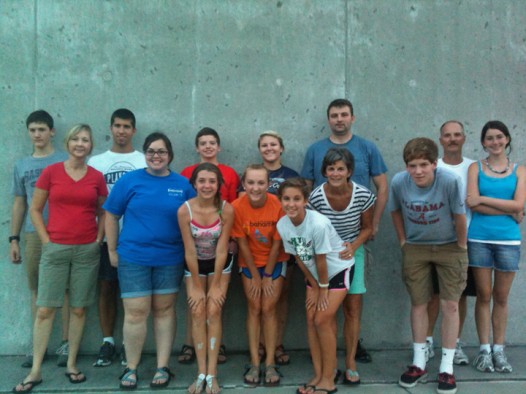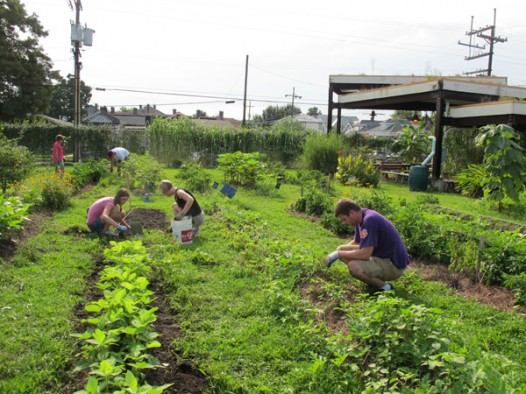Editor’s Note: On August 29, it will have been 15 years since Hurricane Katrina made its land in New Orleans and changed all of our lives. As we move through another tragedy, we want to remember how our community came together and recovered — against all odds. The spirit of New Orleans is not something you can sink easily, and this week we will be publishing stories of hope and rebuilding in order to show that. Stay strong, all!
Summer 2020 marks the ninth year of Camp RHINO, working to rebuild New Orleans. This article was originally published on July 24, 2012.

Camp RHINO participants gather in New Orleans to discover the lessons of Katrina. (Photo by Lauren Plummer)
It’s not your usual summer camp.
For the 50-plus young volunteers from across the country attending last week’s session of Camp RHINO, the only athletic program involved stooping to weed crops at the Edible School Yard, and the nearest thing to arts and crafts consisted of painting walls at Eden House. In between they stocked food bank shelves and worked with mentally challenged adults.
Today, another group of campers is attending the final of four one-week summer sessions created by St. Charles Avenue Presbyterian Church as an outgrowth of its post-Katrina RHINO (Rebuilding Hope in New Orleans) program. The adult version has brought more than 5,000 volunteers to the city, initially to gut ruined houses and, in the past few years, to build more than a dozen new ones.

Campers weed crops at the Edible School Yard at Green Charter School, where a marker inside shows the depth of Katrina flood waters.
“We saw what a difference RHINO was making in the community, and felt this was a way to open it to a new age group, while expanding the mission,” said RHINO project manager Avery Strada.
Planning for Camp RHINO began last fall, with a church focus group brainstorming ideas and activities. Participating institutions and ministries signed on readily, says Strada, and as soon as the sessions were announced, they filled up quickly. Campers have arrived from Texas, Georgia, Alabama, Michigan, Kansas and Florida. Next year, Camp RHINO will expand to six one-week sessions.
“There are not a lot of opportunities like this for youth,” says Lauren Wainwright, youth director of St. Teresa’s Episcopal Church in Acworth, Ga., who accompanied nine campers to New Orleans. “You have to be 16 or 18 for most volunteer work, and I have 12-year-olds I wanted to bring.”
Campers do service work for seven hours each day, and are housed at local universities. Meals and transportation are provided by the staff at St. Charles Avenue Presbyterian. Work sites all are located in areas affected by Hurricane Katrina, and chosen for messages not of destruction, but rebirth. Wherever they go – Magnolia School, Eden House, Second Harvest, the Sculpture Garden at City Park – students hear from directors and staff about background and why the work they are doing is needed.
“There are so many ways to rebuild, and we want to teach young people what hope means, and that you can find hope anywhere,” says Strada. “And, when they go home, perhaps inspire them to give back in similar ways in their own communities.”
Evening programs are designed to put the volunteer activities in perspective, with a focus on urban issues such as education and poverty, how they impact cities, and what can be done to create positive change. Talk might drift to charter schools or transportation concerns, community gardening or “food deserts” – neighborhoods not served by grocery stores.
“We focus on urban issues that occur everywhere, but that were exposed by Hurricane Katrina,” said Strada.
A highlight for many campers is the prayer tour, a two-hour outing to stops such as the Lower 9th Ward, various charter schools, Habitat houses at Ferry Place and Musicians Village. Participants are asked to be contemplative and reflect on what they are seeing.
“It was amazing,” said Wainwright. “It was not about gawking at terrible things, but to see things with hope, and look at the progress.”
“I cried when I saw the Murder Board,” said Alabama camper Lauren Plummer about the big white plaque at St. Anna’s Episcopal Church that lists the names of every person murdered in New Orleans. “It was so eye-opening. But I thought how beautiful it is that every Sunday this congregation prays for all of these families.”
“Our kids are aware of homelessness and other issues,” said Wainwright. “But they’ve never seen anything like this. They can’t believe how neighborhoods change from block to block, or that a school can be 100 years old.”
“We wanted them to get out of our little town and see what happened to New Orleans with the flood,” said Shelly Hardin of Guntersville, Al. “We saw it covered on the news, but never realized the scope of the disaster. And I love the idea that people back home can do similar things there.”
“It made me realize how people here believe they can bring the city back to life,” added Alabama camper Andrew Ellison. “We saw houses abandoned, but others fixed up. “
Like any camp, this one is fun, too. Participants learn jam and jelly making at the Edible School Yard, have pool parties at church members’ homes, attend a Thursday-night dance and enjoy free time to explore the French Quarter and beyond. Camp packets include favorite restaurants, streetcar information, places to see.
But the idea is to send young people home not with sports medals or plastic lanyards, but lasting memories.
“We hope they learn that they are capable of making a difference – that just because they are younger doesn’t mean they can’t do something meaningful,” said Strada. “We hope they get to know the kind of renewed sense of community here – people are amazed at how friendly we are in New Orleans, and that everyone here has a story. And we hope that they get a real-life experience that gives meaning to their faith.”
To that end, campers are required to write letters about what they have seen and experienced and how they were affected by it. In a couple of months, Strada will mail each person his or her letter, as a reminder of lessons learned.
Many groups are blogging online about their experience, too. Alabama camper Emily King posted a Facebook entry talking about what a melting pot the city has become. “I wrote about how riding around smushed in the van we started playing the license plate game. We have only 10 states left to find. And I also mentioned that we painted one wall for a solid hour before learning that we were using the wrong color. It was hilarious.”
Another camper already has been back to New Orleans on vacation with her family, and spent a day volunteering at Magnolia School, where she had worked during Camp RHINO.
“It’s hands-on work, but everywhere they go, they are told how they are bringing hope to the city,” said Strada.
Renee Peck is editor of NolaVie.
 NOLAbeings
Multimedia artist Claire Bangser created NOLAbeings as a portrait-based story project that marries...
NOLAbeings
Multimedia artist Claire Bangser created NOLAbeings as a portrait-based story project that marries...
 Data corner: Adobe Suite (create a PDF, social media graphic, presentation, edit a photo and video
Data corner is where you go to work with analytics and top tech skills. It takes on everything from PERL and SQL to Canva and Sprout Social.
Data corner: Adobe Suite (create a PDF, social media graphic, presentation, edit a photo and video
Data corner is where you go to work with analytics and top tech skills. It takes on everything from PERL and SQL to Canva and Sprout Social.
